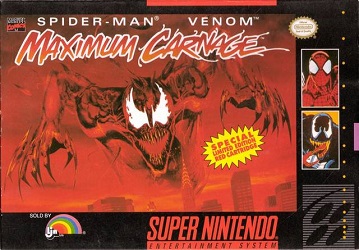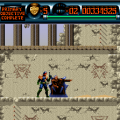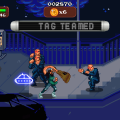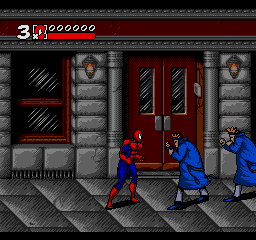- Spider-Man & Venom: Maximum Carnage
- Venom & Spider-Man: Separation Anxiety
For almost two decades following the advent of the NES, Japanese game companies generally dominated the arcade and console landscapes, while Western developers and publishers held sway over the computer-gaming markets in America and Europe, each of them coming to define genres and tropes for increasingly distinct gaming worlds. While Westerners did well on consoles with sports games and the like, they had a harder time replicating the kind of games Japanese studios excelled at, leading to often sub-par attempts at platformers, beat-’em-ups, VS fighters and so on. The controls and gameplay would be clumsy or broken, the visuals rough and amateurish. The difficulty would tend towards the overwhelming in an effort to cope with the rental market, a difference in approach that sometimes affected ports of Japanese games as well. There were, of course, notable exceptions, but those issues were widespread enough to justify this sort of generalization.

Genesis
UK-based Software Creations was one of those Western studios working in mostly Japanese genres of gaming. After coming to some measure of success in the local computer scene with ports of arcade hits like Bubble Bobble and Renegade in the mid-80s, the ’90s saw them entering the console market, where their output largely consisted of mediocre comic book and movie tie-ins for publisher LJN (and later Acclaim). A handful of these titles stood out nonetheless, whether particularly awful or surprisingly decent. Among the latter is a duo of beat-em-ups starring Marvel Comics’s Spider-Man and Venom, the first of which, Maximum Carnage, is well-remembered in certain circles for the iconic red cartridges it was first printed on.
A major crossover story arc published the previous year, the original comics revolve around Spider-Man and his on-and-off enemy Venom’s uneasy alliance to stop Carnage’s murderous rampage follwing his escape from an insane asylum. As Carnage gathers a group of villains in a loose, dysfunctional family, various D-list superheroes get involved in turn, the Fantastic Four and Avengers being “out-of-town”. Eventually, Captain America also lends a hand. Highlights of the comic include Peter Parker and Mary Jane yelling at each other a lot and our heroes stopping rioters with a few seconds of bold moralizing. “Computers make life easy, son — stealing them doesn’t”, says Deathlok to a shamefaced geek running out of a store with a 10-meg PC.

Genesis
The videogame presents a digest version of this story through cutscenes made up of digitized panels from the comic, a rare narrative effort for a mid-90s actioner.
Despite featuring two main characters, however, it’s strictly single-player, a decision that limited its appeal for many. It might have to do with its adherence to the source material, as Venom only becomes selectable after he’s introduced in the story a few levels in. This approach also influences the basic game structure, as it alternates between levels of varying lengths and repeated boss battles against Carnage’s allies that mostly serve to advance the plot. This, along with a climbing level in which you must scale a brick wall while avoiding thunder bolts, creates a breezy, varied experience that sidesteps the monotony plaguing many beat-’em-ups.

Genesis
The protagonists’ web-slinging abilities result in a much wider moveset than is typical. You can shoot web at a nearby enemy to immobilize it or drag it over; using it between two opponents will pull and smash them together, killing most of them instantly. Holding the button lets you use it as a shield, and you can swing around the place by aiming it at ceilings and other pieces of urban furniture. You can climb certain walls, too, to avoid enemy attacks or get to extra lives and restorative items hidden about. Last but not least is the Power Hit, which builds up as you land hits without punching the air or being hit in return. Once your health bar begins flashing, you have a few seconds to pull a powerful attack that can kill several enemies instantly or take a large chunk off of bosses’ health bars. The Power Hits are unique to each character; Spider-Man has a spinning kick that hits immediately in front and behind him, while Venom clubbers the ground so hard to it knocks down everyone standing. They can also pull a powered up throw, but it is generally less useful as it only hurts the opponent they’re holding. Aiming a Power Hit poorly will only waste it, so it’s essential that you develop a feel for using them well in order to advance without taking too much damage.

Genesis
Though their moveset is otherwise identical, Venom is stronger and has more reach, while Spider-Man’s faster. The game will let you choose between them at different points, sometimes resulting in alternate paths. At one point, picking Venom after he’s been captured by Carnage leads to a cutscene where he gets tortured while a CPU-controlled Spider-Man kicks ass on New York rooftops, skipping a few levels entirely. During the epic, multi-part final battle you actually get to switch between both at a button press, a unique mechanic in the genre.
For all these qualities, there’s also a basic flaw in the battle system: throws and grapple moves are too slow and leave you vulnerable to attacks from all sides, making them a liability in crowds as you can easily end up grabbing opponents by accident if you’re not careful.

Genesis
It also needs to be said that the game is hard, with no Options menu in sight to alleviate it, and you shouldn’t get into it expecting to finish it on your first few sessions. First you’ll need to find the extra lives and credits strewn around each major stage. Boss battles are numerous, and they usually put you at a numerical disadvantage. It’s not so bad at first, but in the latter levels, you’ll often have to fight off the whole team, two-by-two, while they get stronger with each appearance: Shriek, Doppelganger, the irritating Demogoblin, the even more irritating Carrion, and finally Carnage himself. By that point, it becomes essential that you make an effort to find as many of the superhero icons as possible and ration out their use intelligently. Each icon summons its corresponding hero for a few seconds to execute attacks of differing properties. Firestar is great against Carnage, for example, while Cloak and Dagger are better at clearing up a screen of minor enemies, Deathlok’s guns can reach Demogoblin, and Iron Fist can either heal you or kick enemies around. These icons start to show up around the middle of the game and can be accumulated throughout the levels; sometimes you may need to shuffle through them (with L and R on the Snes or Start/X on the Genesis) in order for them to show. Other cameos include short-lived Spawn ripoff Nightwatch, Felicia Hardy, Morbius and Captain America.

Genesis
Finally, there are hidden sub-levels filled with various goodies, but you’re unlikely to find many of them without using a FAQ as the requirements to access most are absurdly specific.
If the graphics are just decent, the soundtrack is actually pretty catchy. It was composed by comedy rock band Green Jelly, fresh off their one hit song, Three Little Pigs, and its impressive claymation video. Popular musicians contributing to video games soundtracks was a rarity at the time, and advertisements made sure to underline that fact. A non-chiptune vocal version of the title screen theme appears on their 333 album under the track name “Carnage Rules”.
Maximum Carnage was released simultaneously on the Genesis and SNES. Aside from coloring differences and slightly more detailed backgrounds in the SNES version, they mostly distinguish themselves in the audio department; while the SNES’ music sounds much closer to live instruments, the Genesis’ weird, high-pitched approximation of an electric guitar lends the soundtrack a grungy flavor some might actually prefer. Less debatable, however, are the sound effects, which feel off on the SNES. Punches sound like gunshots, and capturing an opponent with webbing like an explosion; all of it sounds muffled.
Comparison Screenshots

SNES

SNES

Genesis

Genesis






















